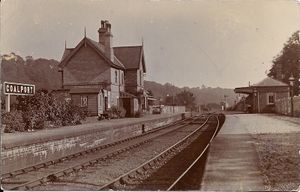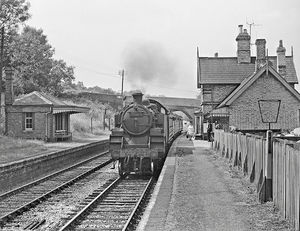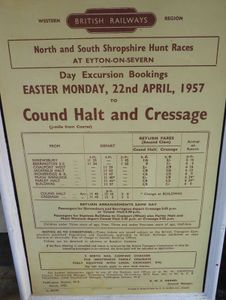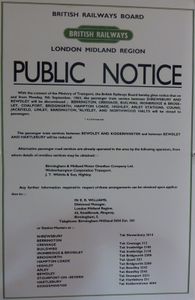Difference between revisions of "Coalport"
m (→See also: add links) |
(Station master information supplied by Chris Haynes) |
||
| (5 intermediate revisions by 3 users not shown) | |||
| Line 15: | Line 15: | ||
The station opened on 1 February 1862 with a single platform. On 28 February 1894, GWR General Manager Henry Lambert proposed that the station should become a crossing place with the addition of a second platform and [[Coalport Brick & Tile Works Siding|additional sidings for Exley & Sons' traffic]] at a total cost of £4,062.<ref name=Marshall108>[[Bibliography#Books|Marshall (1989)]] p. 108.</ref> The [[List of signal boxes#List of historical Signal Boxes and Ground Frames|signal box]] was a GWR <noglossary>Type 5</noglossary> brick signal box with a 31 lever frame comprising 24 working levers and 7 spares. It was situated some way south of the station. The loop was the longest on the Severn Valley Branch with a length of 1,476ft,<ref name=Marshall108/> and for that reason a two-lever ground frame, locked from the signal box, worked the loop points and FPL at the north end of the station. Col. Yorke gave approval of the new works on behalf of the Board of Trade on 22 January 1896.<ref name=Marshall108/> | The station opened on 1 February 1862 with a single platform. On 28 February 1894, GWR General Manager Henry Lambert proposed that the station should become a crossing place with the addition of a second platform and [[Coalport Brick & Tile Works Siding|additional sidings for Exley & Sons' traffic]] at a total cost of £4,062.<ref name=Marshall108>[[Bibliography#Books|Marshall (1989)]] p. 108.</ref> The [[List of signal boxes#List of historical Signal Boxes and Ground Frames|signal box]] was a GWR <noglossary>Type 5</noglossary> brick signal box with a 31 lever frame comprising 24 working levers and 7 spares. It was situated some way south of the station. The loop was the longest on the Severn Valley Branch with a length of 1,476ft,<ref name=Marshall108/> and for that reason a two-lever ground frame, locked from the signal box, worked the loop points and FPL at the north end of the station. Col. Yorke gave approval of the new works on behalf of the Board of Trade on 22 January 1896.<ref name=Marshall108/> | ||
| − | On 27 May 1903, approval was given for an additional bedroom for the Stationmaster’s house at a cost of £84 | + | On 27 May 1903, approval was given for an additional bedroom for the Stationmaster’s house at a cost of £84<ref name=Marshall108/>. |
| + | |||
| + | [[SVR staff in 1922#Severn Valley Railway (North of Bridgnorth)|GWR staff records for 1922]] show the station had a staff of 4. | ||
The ground frame at the north end of the passing loop was removed and replaced by motorised points around 1930.<ref name=Marshall108/> | The ground frame at the north end of the passing loop was removed and replaced by motorised points around 1930.<ref name=Marshall108/> | ||
| + | |||
| + | {| class="wikitable | ||
| + | |+ Station Masters at Coalport | ||
| + | |- | ||
| + | !Name!!Born !! data-sort-type="date" | From !! data-sort-type="date" | To !! Comments | ||
| + | |- | ||
| + | |George Broad||1824, Chute, Wiltshire|| By 1881|| ||Joined Midland Railway by 1841, then West Midlands Railway in 1847. Died 1886. | ||
| + | |- | ||
| + | |Daniel Merrett||1829, Standish, Gloucestershire|| November 1887|| October 1899 || Resigned. Died 1911 | ||
| + | |- | ||
| + | |William Charles Weyman||1857, Berkeley, Gloucestershire|| 17 October 1899|| After 1918 || | ||
| + | |- | ||
| + | |John Thomas||1865, Buildwas|| By April 1923|| || Also station master at [[Linley]] 1904 | ||
| + | |- | ||
| + | |Frederick Harold Jones||1890, Burwarton, Shropshire|| By July 1926|| By September 1928 || | ||
| + | |- | ||
| + | |Edward Parry Jones||1884, Welshampton|| By October 1928|| By April 1932 || | ||
| + | |- | ||
| + | |} | ||
| + | |||
| + | From 1941 Coalport came under the supervision of Ironbridge and Broseley. | ||
| + | |||
| + | During the BR era the station was renamed 'Coalport West',<ref>[[Bibliography#Other References|Butt (1995)]]</ref> presumably to differentiate it from the nearby ex-LNWR 'Coalport East' station. The change seems to have had little impact in practice, as use of the original name "Coalport" continued in [[Engineer's Line References]], [[Timetables in commercial service|BR Working Timetables]], and on the platform running in boards.<ref>[[Bibliography#Books|Mitchell and Smith (2007)]] fig. 83.</ref> The 1963 BR notice of closure of the line also referred to the station only as Coalport. However the 'Coalport West' name was used from time to time, such as on a 1957 excursion poster and in the 1960 Sectional Appendix to the Working Time Table. | ||
| + | <gallery mode=packed heights=200px style="text-align:left"> | ||
| + | BR Excursion Poster 1957.jpg|1957 Easter Monday excursion poster showing 'Coalport West' | ||
| + | Closure Notice.jpg|1963 closure notice showing 'Coalport' | ||
| + | </gallery> | ||
The station closed to passengers from 9 September 1963. The signal box was closed on 2 December 1963 after through freight services ended. The station building is now a private house. In May 2017 it was offered for sale at a price of £950,000.<ref>[http://www.rightmove.co.uk/property-for-sale/property-66631712.html Rightmove.co.uk] retrieved 1 August 2017</ref> | The station closed to passengers from 9 September 1963. The signal box was closed on 2 December 1963 after through freight services ended. The station building is now a private house. In May 2017 it was offered for sale at a price of £950,000.<ref>[http://www.rightmove.co.uk/property-for-sale/property-66631712.html Rightmove.co.uk] retrieved 1 August 2017</ref> | ||
==Coalport passing loop operating instructions== | ==Coalport passing loop operating instructions== | ||
| − | The [[The Severn Valley Railway under GWR/BR ownership# Timetable extracts | BR(W) Working Timetables]] for 1948 and 1959 include the following operating instruction specific to Coalport: ''When a Freight Train is standing in either of the sidings on the Up Side at Coalport, waiting for a train to pass, the Guard must divide his train to provide space for the Signalman to pass through for the purpose of exchanging train staffs with the passing train''. | + | The [[The Severn Valley Railway under GWR/BR ownership# Timetable extracts | BR(W) Working Timetables]] for 1948 and 1959 include the following operating instruction specific to Coalport: ''When a Freight Train is standing in either of the sidings on the Up Side at Coalport, waiting for a train to pass, the Guard must divide his train to provide space for the Signalman to pass through for the purpose of exchanging train staffs with the passing train''.<br> |
| + | In 1960 the loop capacity was 27 wagons, plus engine and brake van.<ref>Sectional Appendix to the Working Time Tables and Books of Rules and Regulations, Birmingham Traffic District, October 1960</ref> | ||
==Traffic statistics== | ==Traffic statistics== | ||
{| class="wikitable" | {| class="wikitable" | ||
| − | |+ [[ | + | |+ [[Traffic statistics in commercial service]] for Coalport, selected years 1903 to 1952 |
|- | |- | ||
! !! colspan="3" | Passenger Traffic !! colspan="2" | Freight Traffic !! | ! !! colspan="3" | Passenger Traffic !! colspan="2" | Freight Traffic !! | ||
| Line 42: | Line 72: | ||
|- | |- | ||
|1938||style="text-align:right"|5,741||style="text-align:right"|1,257||style="text-align:right"|366||style="text-align:right"|4,937||style="text-align:right"|1,771||style="text-align:right"|2,137 | |1938||style="text-align:right"|5,741||style="text-align:right"|1,257||style="text-align:right"|366||style="text-align:right"|4,937||style="text-align:right"|1,771||style="text-align:right"|2,137 | ||
| + | |- | ||
| + | |1942||style="text-align:right"|7,621||style="text-align:right"|161||style="text-align:right"|580||style="text-align:right"|6,132||style="text-align:right"|X||style="text-align:right"|X | ||
| + | |- | ||
| + | |1947||style="text-align:right"|7,145||style="text-align:right"|138||style="text-align:right"|541||style="text-align:right"|499||style="text-align:right"|X||style="text-align:right"|X | ||
| + | |- | ||
| + | |1952||style="text-align:right"|4,675||style="text-align:right"|261||style="text-align:right"|367||style="text-align:right"|X||style="text-align:right"|X||style="text-align:right"|X | ||
|- | |- | ||
|} | |} | ||
| − | + | X: Information not recorded | |
== Gallery == | == Gallery == | ||
| Line 56: | Line 92: | ||
*[[Maps#Schematic maps of the pre-closure SVR | Pre-1963 map]] | *[[Maps#Schematic maps of the pre-closure SVR | Pre-1963 map]] | ||
*[[Shropshire Historic Environment Record]] | *[[Shropshire Historic Environment Record]] | ||
| + | *[[Variant spellings of SVR station names]] | ||
==References== | ==References== | ||
| + | Station master information supplied by Chris Haynes | ||
The Severn Valley Railway, John Marshall<br> | The Severn Valley Railway, John Marshall<br> | ||
Severn Valley Railway, A View from the Past, MA Vanns<br> | Severn Valley Railway, A View from the Past, MA Vanns<br> | ||
Latest revision as of 15:12, 30 July 2023
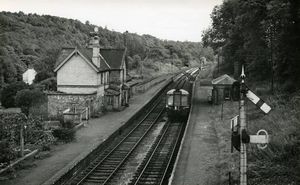
| Towards Hartlebury and Kidderminster | Towards Shrewsbury |
|---|---|
| Linley (2½ miles) | Ironbridge (2 miles) via Jackfield Halt (from 1934) |
Coalport Station was located 25 miles from Hartlebury and 15¾ miles from Shrewsbury.
History
The station opened on 1 February 1862 with a single platform. On 28 February 1894, GWRGreat Western Railway General Manager Henry Lambert proposed that the station should become a crossing place with the addition of a second platform and additional sidings for Exley & Sons' traffic at a total cost of £4,062.[1] The signal box was a GWRGreat Western Railway Type 5 brick signal box with a 31 lever frame comprising 24 working levers and 7 spares. It was situated some way south of the station. The loop was the longest on the Severn Valley Branch with a length of 1,476ft,[1] and for that reason a two-lever ground frame, locked from the signal box, worked the loop points and FPLFacing Point Lock, equipment that physically locks points so that they cannot move. at the north end of the station. Col. Yorke gave approval of the new works on behalf of the Board of Trade on 22 January 1896.[1]
On 27 May 1903, approval was given for an additional bedroom for the Stationmaster’s house at a cost of £84[1].
GWR staff records for 1922 show the station had a staff of 4.
The ground frame at the north end of the passing loop was removed and replaced by motorised points around 1930.[1]
| Name | Born | From | To | Comments |
|---|---|---|---|---|
| George Broad | 1824, Chute, Wiltshire | By 1881 | Joined Midland Railway by 1841, then West Midlands Railway in 1847. Died 1886. | |
| Daniel Merrett | 1829, Standish, Gloucestershire | November 1887 | October 1899 | Resigned. Died 1911 |
| William Charles Weyman | 1857, Berkeley, Gloucestershire | 17 October 1899 | After 1918 | |
| John Thomas | 1865, Buildwas | By April 1923 | Also station master at Linley 1904 | |
| Frederick Harold Jones | 1890, Burwarton, Shropshire | By July 1926 | By September 1928 | |
| Edward Parry Jones | 1884, Welshampton | By October 1928 | By April 1932 |
From 1941 Coalport came under the supervision of Ironbridge and Broseley.
During the BRBritish Rail or British Railways era the station was renamed 'Coalport West',[2] presumably to differentiate it from the nearby ex-LNWRLondon & North Western Railway 'Coalport East' station. The change seems to have had little impact in practice, as use of the original name "Coalport" continued in Engineer's Line References, BR Working Timetables, and on the platform running in boards.[3] The 1963 BRBritish Rail or British Railways notice of closure of the line also referred to the station only as Coalport. However the 'Coalport West' name was used from time to time, such as on a 1957 excursion poster and in the 1960 Sectional Appendix to the Working Time Table.
The station closed to passengers from 9 September 1963. The signal box was closed on 2 December 1963 after through freight services ended. The station building is now a private house. In May 2017 it was offered for sale at a price of £950,000.[4]
Coalport passing loop operating instructions
The BR(W) Working Timetables for 1948 and 1959 include the following operating instruction specific to Coalport: When a Freight Train is standing in either of the sidings on the UpIn reference to the direction of travel means towards the major terminus (i.e. towards Kidderminster on the present day SVR) Side at Coalport, waiting for a train to pass, the Guard must divide his train to provide space for the Signalman to pass through for the purpose of exchanging train staffs with the passing train.
In 1960 the loop capacity was 27 wagons, plus engine and brake van.[5]
Traffic statistics
| Passenger Traffic | Freight Traffic | |||||
|---|---|---|---|---|---|---|
| Year | Tickets issued | Parcels despatched | Revenue (£) | Tons received & despatched | Revenue (£) | Total revenue (£) |
| 1903 | 7,906 | 1,325 | 493 | 11,021 | 3,820 | 4,313 |
| 1913 | 6,622 | 1,257 | 490 | 6,823 | 1,850 | 2,340 |
| 1923 | 8,984 | 1,885 | 754 | 9,253 | 3,857 | 4,611 |
| 1933 | 5,771 | 690 | 412 | 5,950 | 2,750 | 3,162 |
| 1938 | 5,741 | 1,257 | 366 | 4,937 | 1,771 | 2,137 |
| 1942 | 7,621 | 161 | 580 | 6,132 | X | X |
| 1947 | 7,145 | 138 | 541 | 499 | X | X |
| 1952 | 4,675 | 261 | 367 | X | X | X |
X: Information not recorded
Gallery
An ex-GWRGreat Western Railway prairie pulls a short northbound goods through Coalport in July 1962 (Sellick Collection)
A southbound train arrives at Coalport in August 1963 (Sellick Collection)
See also
- The Severn Valley Railway under GWR/BR ownership
- Pre-1963 map
- Shropshire Historic Environment Record
- Variant spellings of SVR station names
References
Station master information supplied by Chris Haynes
The Severn Valley Railway, John Marshall
Severn Valley Railway, A View from the Past, MA Vanns
- ↑ 1.0 1.1 1.2 1.3 1.4 Marshall (1989) p. 108.
- ↑ Butt (1995)
- ↑ Mitchell and Smith (2007) fig. 83.
- ↑ Rightmove.co.uk retrieved 1 August 2017
- ↑ Sectional Appendix to the Working Time Tables and Books of Rules and Regulations, Birmingham Traffic District, October 1960
| ||||||||||||||||||||
